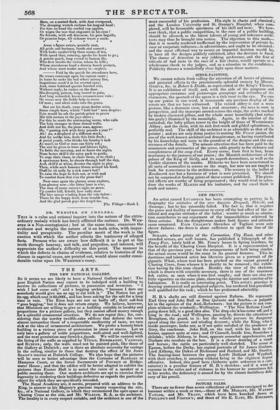THE ARTS.
THE NEW NATIONAL GALLERY.
So it seems we are likely to have a National Gallery at last ! The poor English Nation may expect to be indulged with a building to receive its collections of pictures, in possession and reversion. " I wish I had some salt," said a begging urchin, "because I dare say somebody would give me an egg to eat with it." The Nation has got its egg, which cost it 60,0001., and has been asking for the salt for a long time in vain. The Eton boys are not so badly off; their salt-box "goes begging," but it does not return empty. We believe, however, that Ministers are willing to give us a building suitable in locality and proportions for a picture gallery, but they cannot afford money enough for a splendid ornamental structure. We do not regret this ; for, con- sidering that the tawdry twelfth-cake edifices that deform the town almost outnumber those of a respectable mediocrity of taste, we turn sick at the idea of ornamental architecture. We prefer a homely brick building to a vicious piece of pretension in stone or stucco. Let us only have a gallery of noble proportions, well-aired and well-lighted, and the next generation may furnish a fagade. We will be content with the lining of the walls RS supplied by TITIAN, REMBRANDT, VANDYKE, and RUBENS ; only, the walls must not be painted pink, like those of the Gallery at Dulwich ; nor is there an absolute necessity for covings in the ceiling, similar to those that destroy the effect of Sir Josii SOANE'S interior at Dulwich College. We also hope that the pictures will be seen to better advantage than the Cartoons of RAPHAEL at Hampton Court, or the Seven Sacraments of Poussn: at Bridge- water House ; and that the edifice will be better adapted to exhibit the pictures than Exeter Hall is to assist the voice of a speaker at a public meeting there. Our modern architects are apt to exercise their Ingenuity in rendering their buildings defective as regards the particular object for which they are specifically intended. The Royal Academy are, it seems, prepared with an address to the King, in answer to his Majesty's gracious inquiry respecting the site, &c., of a National Gallery, in which they recommend the open space at Charing Cross as the site, and Mr. WILKINS, R. A. as the architect. The locality is in every respect suitable, and the architect is one of the most successful of his profession. His style is chaste and classical; and the London University and St. George's Hospital, when com-
pleted, will be favourable specimens of his skill and taste. We how-
ever think, that a public competition, in the case of a public building,, should be allowed, as the latent talents of young and unknown archi- tects may thus be brought into notice. The objection to this modei-- that it is usually rendered ineffectual by the intervention of private fa- vour or corporate influence—is adventitious, and ought to be obviated : and the most effectual way to secure an impartial decision would be, to have all the designs publicly exhibited, after the decision is fixed. The shame of detection in any jobbing preference, and the fear of ridicule of bad taste in the case of a fair choice, would operate as a wholesome check to the judges, and as a stimulus to the candidates. Publicity throws a wonderfully clear light upon these matters.



























 Previous page
Previous page